

Pandava. Kurukshetra War. Akbar. Third Mughal emperor Badshah of the Mughal Empire Abu'l-Fath Jalal-ud-din Muhammad Akbar[7] (Persian: ابو الفتح جلال الدين محمد اكبر; October 1542[a]– 27 October 1605),[10][11] popularly known as Akbar the Great,[12][13][14][15] (Akbar-i-azam اکبر اعظم), and also as Akbar I (IPA: [əkbər]),[16] was the third Mughal emperor, who reigned from 1556 to 1605.

Akbar succeeded his father, Humayun, under a regent, Bairam Khan, who helped the young emperor expand and consolidate Mughal domains in India. A strong personality and a successful general, Akbar gradually enlarged the Mughal Empire to include most of the Indian subcontinent. His power and influence, however, extended over the entire subcontinent because of Mughal military, political, cultural, and economic dominance. Mughal India developed a strong and stable economy, leading to commercial expansion and greater patronage of culture. Razmnama. The Razmnāma (Book of War) (رزم نامہ) is a Persian translation of the Mahabharata.

In Persian, “Razm” means “war” and "nama" means “tale” or “epic”; the name Razmnamah, therefore, means a tale of war. In 1574, Akbar started an Maktab Khana or a house of translation works in Fatehpur Sikri. He assigned the work to a few officials to translate the Sanskrit books Rajatarangini, Ramayana and Mahabharata into the Persian language.[1] Three editions are known, one made between 1584 and 1586 is in the Jaipur palace. and includes 176 paintings of which 147 were reproduced in 1884 by Thomas Holbein Hendley.
I Gusti Putu Phalgunadi. Dr.
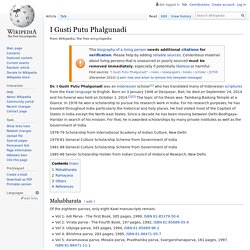
I Gusti Putu Phalgunadi was an Indonesian scholar[1] who has translated many of Indonesian scriptures from the Kawi language to English. Born on 3 January 1948 at Denpasar, Bali, he died on September 24, 2014 and his funeral was held on October 1, 2014.[2][3] The topic of his thesis was: Tambang Badung Temple at a Glance. In 1978 he won a scholarship to pursue his research work in India.
For his research purposes, he has traveled throughout India particularly the historical and holy places. Bali. Province in Indonesia Bali is a province of Indonesia and the westernmost of the Lesser Sunda Islands.

Located east of Java and west of Lombok, the province includes the island of Bali and a few smaller neighbouring islands, notably Nusa Penida, Nusa Lembongan, and Nusa Ceningan. Kawi language. Kawi, or Old Javanese, is the oldest attested phase of the Javanese language.
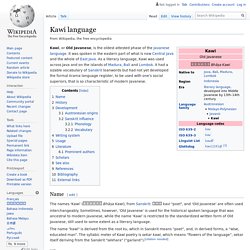
It was spoken in the eastern part of what is now Central Java and the whole of East Java. As a literary language, Kawi was used across Java and on the islands of Madura, Bali and Lombok. It had a sizable vocabulary of Sanskrit loanwords but had not yet developed the formal krama language register, to be used with one's social superiors, that is so characteristic of modern Javanese. Arjunawiwaha. Arjunawiwāha was the first kakawin appeared in the East Javan period of the Javanese classical Hindu-Buddhist era in the 11th-century.

Arjunawiwaha was composed by Mpu Kanwa during the reign of King Airlangga, king of the Kahuripan Kingdom, circa 1019 to 1042 CE. Arjunawiwaha is estimated to be finished in 1030. The Kakawin tells the story of Arjuna when he was engaged in meditation and performing a severe practice of asceticism on Mount Meru. Petruk. Character in Javanese puppetry Petruk is a character in traditional Javanese puppetry, or wayang.

Semar. Semar is a character in Javanese mythology who frequently appears in wayang shadow plays.
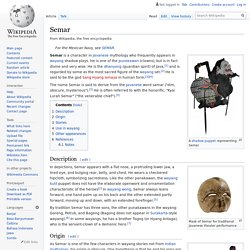
He is one of the punokawan (clowns), but is in fact divine and very wise. He is the dhanyang (guardian spirit) of Java,[1] and is regarded by some as the most sacred figure of the wayang set.[2] He is said to be the god Sang Hyang Ismaya in human form.[3][4] The name Semar is said to derive from the Javanese word samar ("dim, obscure, mysterious").[3] He is often referred to with the honorific, "Kyai Lurah Semar" ("the venerable chief").[3] Punokawan. Panakawans (right) accompanied their masters in a traditional Wayang Wong theater performance in Yogyakarta.
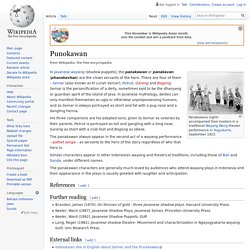
September 1923. In Javanese wayang (shadow puppets), the panakawan or panakavan (phanakavhan) are the clown servants of the hero. There are four of them – Semar (also known as Ki Lurah Semar), Petruk, Gareng and Bagong. Swayamvara. Swayamvara (Sanskrit: स्वयंवर, IAST: svayaṃvara), in ancient India, was a practice of choosing a husband, from among a list of suitors, by a girl of marriageable age.
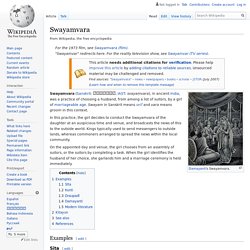
Swayam in Sanskrit means self and vara means groom in this context. In this practice, the girl decides to conduct the Swayamvara of the daughter at an auspicious time and venue, and broadcasts the news of this to the outside world. Kings typically used to send messengers to outside lands, whereas commoners arranged to spread the news within the local community. On the appointed day and venue, the girl chooses from an assembly of suitors, or the suitors by completing a task. Gandhari. From Wikipedia, the free encyclopedia Jump to navigationJump to search Gandhari may refer to: Arjuna. Character from Indian epic Mahabharata Arjuna (Sanskrit: अर्जुन, IAST: arjuna) is a central character of the Indian epic Mahabharata. Arjuna was the son of Pandu in the Kuru Kingdom. Shikhandi.
Past Life[edit] In the majority of the versions of the Mahabharata,[1] there is the story of Shikhandi being Amba in his previous birth. Vichitravirya married only two sisters, because Amba told Bhishma that she had fallen in love with Salwa, and was not ready to marry anyone else. Hearing this from her, Bhishma sent Amba with grandeur to Saubala. But Salwa rejected her as well, in shame of losing the combat against Bhishma. Amba then returned to Bhishma and demanded that he marry her according to Kshatriya dharma, but Bhishma declined due to his vow of celibacy. Amba did severe penance to Lord Shiva for a boon to cause Bhishma's death. Subhadra. Character from Indian epic Mahabharata Subhadra (IAST: Subhadrā) is a character in the Mahabharata which Hindu legend ascribes to Vyasa.
She is worshiped as an incarnation of Goddess Yogmaya. Polyandry. Polyandry (; from Greek: πολυ- poly-, "many" and ἀνήρ anēr, "man") is a form of polygamy in which a woman takes two or more husbands at the same time. Polyandry is contrasted with polygyny, involving one male and two or more females. If a marriage involves a plural number of "husbands and wives" participants of each gender, then it can be called polygamy,[1] group or conjoint marriage.[2] In its broadest use, polyandry refers to sexual relations with multiple males within or without marriage. Of the 1,231 societies listed in the 1980 Ethnographic Atlas, 186 were found to be monogamous; 453 had occasional polygyny; 588 had more frequent polygyny; and 4 had polyandry.[3] Polyandry is less rare than this figure suggests, as it considered only those examples found in the Himalayan mountains (28 societies).
More recent studies have found more than 50 other societies practicing polyandry.[4] Yudhishthira. Draupadi. Main female character in the Indian epic Mahabharata Draupadi (Sanskrit: द्रौपदी, lit. Wayang. Javanese wayang kulit (shadow puppet) performance by dalang (puppet master) Ki Manteb Sudharsono. Wayang wong. Wayang wong, also known as wayang orang (literally "human wayang"), is a type of classical Javanese dance theatrical performance with themes taken from episodes of the Ramayana or Mahabharata. Bali. Dharmawangsa. Dharmawangsa (also spelled Dharmavamsa), stylized regnal name Sri Maharaja Isyana Dharmawangsa Teguh Anantawikramottunggadewa of Isyana dynasty was the last raja of the Kingdom of Medang reigned from 990-1016 CE. He also known in his posthumous name Wijayamreta Wardhana which means "powerful in glorious death", which refer to his fight to the death.
Kakawin Bhāratayuddha. First page of Gunning's kakawin Bhāratayuddha (1903) in Javanese characters. Java. Indonesia. Country in Southeast Asia Coordinates: 5°S 120°E / 5°S 120°E / -5; 120 Indonesia ( IN-də-NEE-zhə, -NEE-zee-ə; Indonesian: [ɪndoˈnesia]), officially the Republic of Indonesia (Indonesian: Republik Indonesia [reˈpublik ɪndoˈnesia]),[a] is a country in Southeast Asia, between the Indian and Pacific oceans. It is the world's largest island country, with more than seventeen thousand islands,[12] and at 1,904,569 square kilometres (735,358 square miles), the 14th largest by land area and 7th in the combined sea and land area.[13] With over 267 million people, it is the world's 4th most populous country as well as the most populous Muslim-majority country. Wayang wong. Pandava. Kattaikkuttu. Terukkuttu. Tamil culture. Harivamsa. Pune. Bhandarkar Oriental Research Institute. Just war theory. Dharma-yuddha. God.
Svarga. Janamejaya. Parikshit. Himalayas. Gandhari. Persian language. Yuyutsu. Kritavarma. Ashwatthama. Kripa. Satyaki. Bhagavad Gita. Kshatriya. Drona. Bhishma. Pilgrimage. Balarama. Kambojas. Bahlikas. Gandhara. Madra. Avanti. Sindh. Anga. Kaurava. Pandava. Parama Kamboja Kingdom. Mathura. Yadu. Trilinga Kshetras. Pandya dynasty. Chedi Kingdom. Matsya. Magadha. Kekaya. Dvārakā. Panchala. Kurukshetra. Angkor Wat. Kurukshetra War. Virata. Arjuna. Bhima. Danava. Mayasura. Subhadra. Indraprastha. Takshaka. Polyandry. Brahmin. Draupadi. Panchala. Swayamvara. Hoysala Empire. Chennakeshava Temple, Belur. Hidimba. Vidura. Purochana. Kurukshetra. Vikarna. Dushasana. Duryodhana. Kaurava.